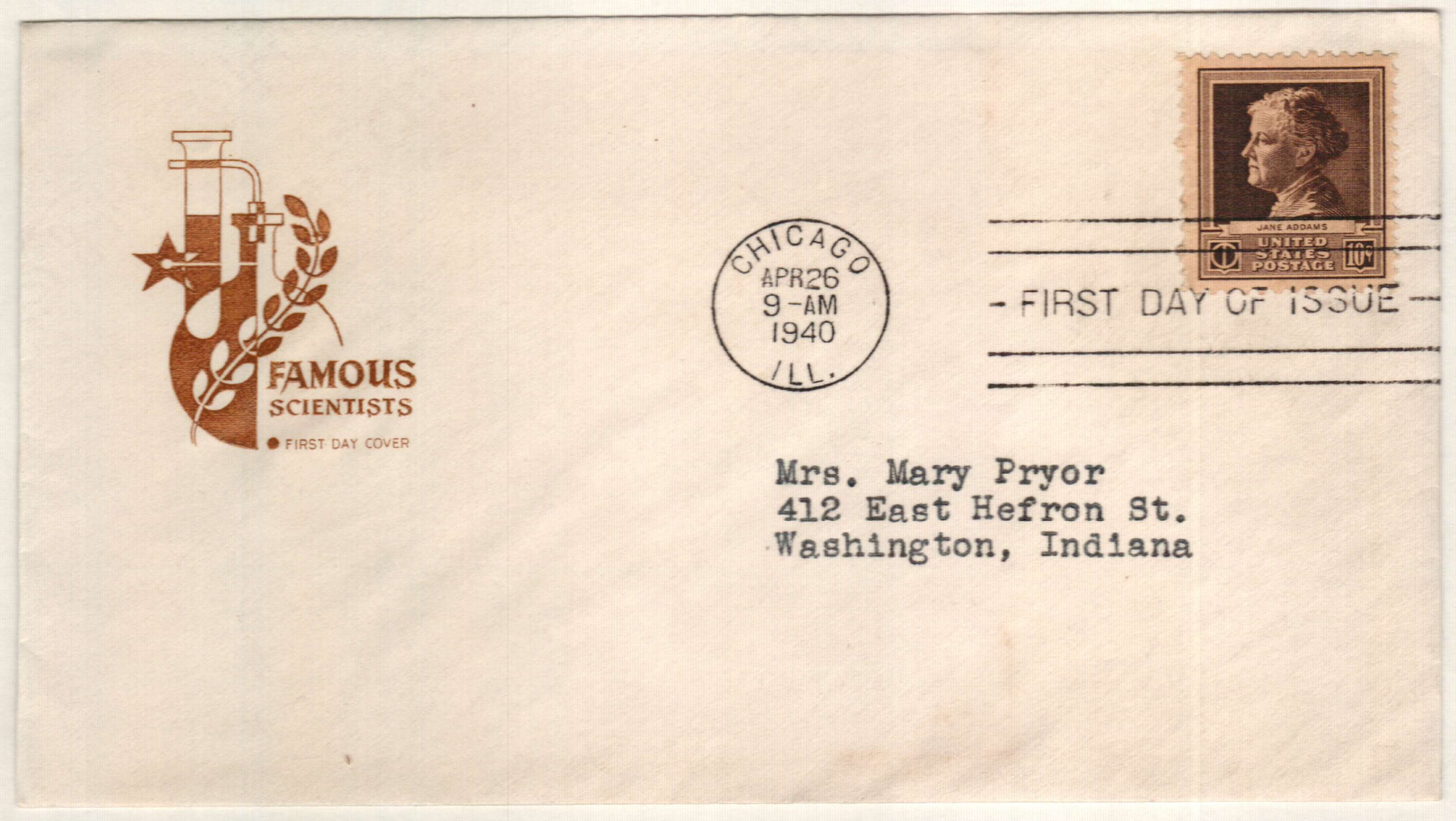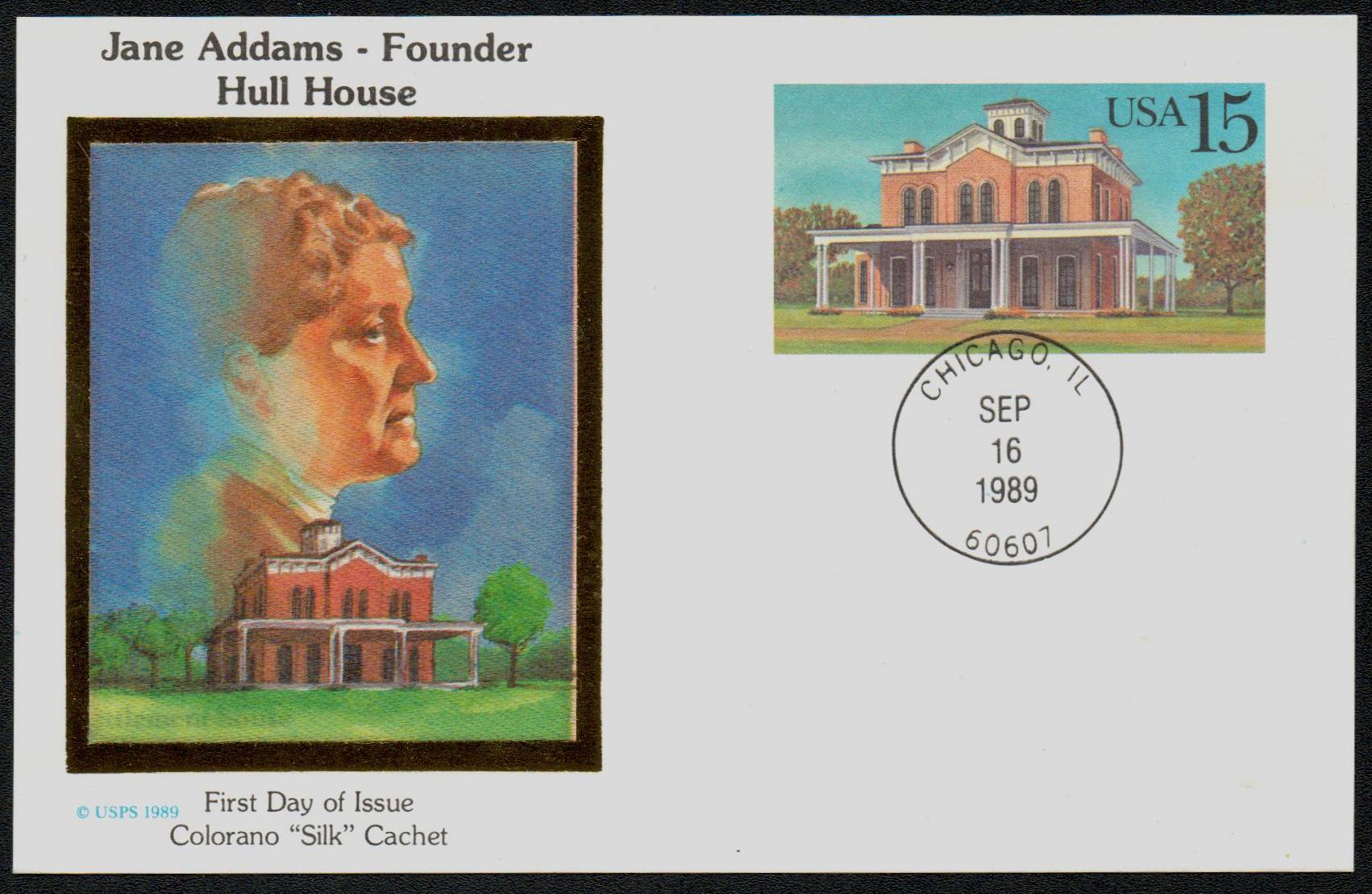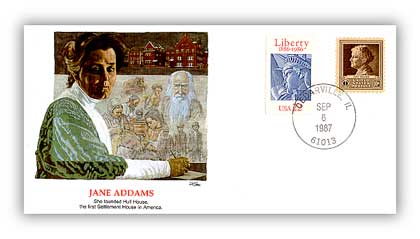
# UX134 FDC - 1989 15c Postal Card - Hull House
Postal Cards
Postal cards are postal stationery with an imprinted stamp or indicium signifying the prepayment of postage. Highly collectable, they would make a great complement to any stamp or cover collection.
Birth Of Jane Addams
The eighth of nine children, Adams was the daughter of a local political leader, Civil War officer, and friend of Abraham Lincoln. She graduated from the Rockford Female Seminary as valedictorian in 1881.
Addams went on to study medicine, but she eventually abandoned that due to poor health, being admitted to the hospital several times. When she was well, Addams spent nearly two years in Europe studying and considering what she wanted to do with her future. On a second trip to Europe when she was 27, Addams and her friend Ellen Starr visited the Toynbee Hall Settlement House in London’s East End. This visit inspired her to open a similar home for the needy in Chicago.

In 1889, Addams and Starr leased a house owned by Charles Hull on the corner of Halsted and Polk Streets. Their goal was “to provide a center for a higher civic and social life; to institute and maintain educational and philanthropic enterprises, and to investigate and improve the conditions in the industrial districts of Chicago.”

Addams and Starr began a large-scale campaign to raise support for their project, delivering speeches about the importance of helping the neighborhood, raising money, and encouraging wealthy young women to volunteer to help. By their second year in operation, the Hull House served about 2,000 people every week. They offered kindergarten classes, clubs for older children, and courses for adults in the evenings, effectively offering a night school. Hull House quickly began to expand to include an art gallery, a second kitchen, a coffee house, a gym, an art studio, a music school, a library, an employment office, and a labor museum.

Addams became well known for her efforts with the Hull House, which led her to additional prominent positions. She was selected to serve as chairman of the School Management Committee of the Chicago Board of Education, helped found the Chicago School of Civics and Philanthropy, and served as the first female president of the National Conference of Charities and Corrections. She also received the first honorary degree given to a woman from Yale University in 1910.

Addams often spoke on how women played a major role in cleaning up their communities. And if they wanted to be effective and make lasting change, they should have the right to vote. Addams opposed America’s entry into World War I and was chairman of the Women’s Peace Party. Once the US entered the war, she joined Herbert Hoover in collecting food and supplies for the women and children of enemy nations.

Addams suffered a heart attack in 1926, after which her health never fully recovered. On December 10, 1931, she became the first American woman to receive the Nobel Peace Prize for her work, and she is often considered the founder of the profession of social work in America. Addams died on May 21, 1935.
Postal Cards
Postal cards are postal stationery with an imprinted stamp or indicium signifying the prepayment of postage. Highly collectable, they would make a great complement to any stamp or cover collection.
Birth Of Jane Addams
The eighth of nine children, Adams was the daughter of a local political leader, Civil War officer, and friend of Abraham Lincoln. She graduated from the Rockford Female Seminary as valedictorian in 1881.
Addams went on to study medicine, but she eventually abandoned that due to poor health, being admitted to the hospital several times. When she was well, Addams spent nearly two years in Europe studying and considering what she wanted to do with her future. On a second trip to Europe when she was 27, Addams and her friend Ellen Starr visited the Toynbee Hall Settlement House in London’s East End. This visit inspired her to open a similar home for the needy in Chicago.

In 1889, Addams and Starr leased a house owned by Charles Hull on the corner of Halsted and Polk Streets. Their goal was “to provide a center for a higher civic and social life; to institute and maintain educational and philanthropic enterprises, and to investigate and improve the conditions in the industrial districts of Chicago.”

Addams and Starr began a large-scale campaign to raise support for their project, delivering speeches about the importance of helping the neighborhood, raising money, and encouraging wealthy young women to volunteer to help. By their second year in operation, the Hull House served about 2,000 people every week. They offered kindergarten classes, clubs for older children, and courses for adults in the evenings, effectively offering a night school. Hull House quickly began to expand to include an art gallery, a second kitchen, a coffee house, a gym, an art studio, a music school, a library, an employment office, and a labor museum.

Addams became well known for her efforts with the Hull House, which led her to additional prominent positions. She was selected to serve as chairman of the School Management Committee of the Chicago Board of Education, helped found the Chicago School of Civics and Philanthropy, and served as the first female president of the National Conference of Charities and Corrections. She also received the first honorary degree given to a woman from Yale University in 1910.

Addams often spoke on how women played a major role in cleaning up their communities. And if they wanted to be effective and make lasting change, they should have the right to vote. Addams opposed America’s entry into World War I and was chairman of the Women’s Peace Party. Once the US entered the war, she joined Herbert Hoover in collecting food and supplies for the women and children of enemy nations.

Addams suffered a heart attack in 1926, after which her health never fully recovered. On December 10, 1931, she became the first American woman to receive the Nobel Peace Prize for her work, and she is often considered the founder of the profession of social work in America. Addams died on May 21, 1935.













